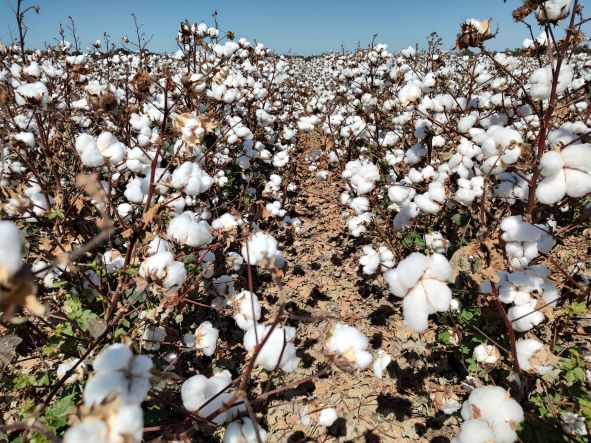Shurley on Cotton: Market Implodes
By Dr. Don Shurley
Everyone wants to know what has happened to the market and why? Unfortunately, there are no easy answers.
Most analysts saw the possible range in prices for the 2014 crop to be from 70 to 85 cents, with 70 to 75 cents being the pessimistic outlook and 85 cents being the top, or optimistic, outlook.
The combination of factors/forces that would lead to the low end of that range in prices certainly appears to have materialized. In fact, we’ve seen prices (Dec14 futures) drop from about 85 cents in early May to 68 cents, closing at 68.12 on July 11. Prices were able to hold support at around 76 cents or better for most of June, but it’s been a freefall since then.
USDA recently released its much anticipated July production and supply/demand numbers. But prices had already begun their slide two weeks ago, so it’s hard to lay the blame completely on that report. Having said that, however, over the past couple of weeks, analysts had already begun to anticipate today’s numbers and factor that into prices. Thus, the slide had already begun. The report not only confirmed those expectations, the numbers were actually more than expected – and even worse for prices.
The U.S. crop is estimated at 16.5 million bales. This is based on the June acres planted estimate, an abandonment of only 15 percent, and a yield of 816 lbs/acre.
The August report will be the first to contain an actual survey-based yield estimate for this year’s crop. Crop conditions have improved, and the August production estimate could move even higher. As of July 6, 55 percent of the U.S. crop was rated good to excellent, compared to 53 percent for the previous week and 44 percent last year.
U.S. exports for 2014/15 are pegged at 10.2 million bales. This compares to 9.7 million in the June estimate and 10.5 million bales last year. Given the abundance of stocks in China and worldwide, exports of over 10 million bales would be better than thought possible. It could also simply be reflecting higher export supplies and lower prices.
U.S. ending stocks are projected to be 5.2 million bales at the end of the 2014 crop marketing year – up from 2.7 million bales on-hand going in.
On the foreign and total World picture, the report continues to trend in the wrong direction. World stocks at the end of the 2014 crop year are now projected to be 105.7 million bales – up another three million bales from the June estimate. Some of this is accounted for by the U.S. increase. The bulk of the rest of it is further increase in China.
For the 2013 crop marketing year that will conclude on July 31, USDA lowered China’s cotton Use by one million bales.
There were no other changes, so this increases 2013/14 ending stocks (2014/15 beginning stocks) by that one million bales. China’s Use for the 2014 crop year was lowered a half million bales from the June projection. So, in total, China’s stocks projected to be on-hand next year this time were upped 1.5 million bales from the June estimate.
It’s projected that China’s stocks will increase another one million bales this season (from 61.31 to 62.26 million bales). The Chinese stocks situation is not new. These stocks have been building since 2010, and the market (prices) has dealt with this for going on four years.
Chinese stocks have been the bomb waiting to explode. But the market could, for the most part, ignore it for two reasons: (1) China wasn’t using the stocks, so in the short-term the big supply didn’t matter, and (2) stocks outside of China (in the rest of the world – ROW) were “tight.”
Well, as it ends up, neither of these were 100 percent true, and this was pointed out during producer meetings this past winter. Regardless of the reasons and stocks policies, the fact is that China will import much less cotton for the 2014 crop season. That’s can’t be good for the U.S. that depends on exports and China being our number one buyer. Also, the ROW stocks that were said to be “tight” were, in fact over time, getting less tight during the past season as evidenced by the trend in USDA’s monthly numbers. As it ends up, ROW ending stocks for 2013 were greater than for 2012 and not that much lower than previous years. Today’s numbers show stocks in both China and the ROW are expected to continue to grow.
Prices are likely to remain under the pressure of potentially large supplies. World Use at 111 million bales, compared to 112 million projected in June, also doesn’t help. It appears that the pessimistic worst case is being realized. Producers are fortunate if they already have a fair portion of expected 2014 production priced. Otherwise, it could be tough for prices to mount much of a comeback between now and harvest unless supply shocks take place and/or demand improves.
There may still be enough optimism out there to think we’ve slipped too far, too fast. But will anybody risk being a buyer in this market until something bullish actually happens? This market desperately needs stability – something to stop the free fall. If prices don’t bounce back to your satisfaction between now and harvest, you’ll have to wait and give the market longer to hopefully adjust back up over the winter.
Shurley is Professor Emeritus of Agricultural Economics, Department of Agricultural and Applied Economics, University of Georgia









